Orbital-dependent electron correlation in double-layer nickelate La3Ni2O7
20/06/2024 IntroductionThe superconductivity in cuprates is realized by doping the Mott insulators and strong electron correlation is believed to be essential to produce high temperature superconductivity1,2,3,4. Great efforts have been made to search for high temperature superconductivity in nickelates which have similiar structural and electronic characteristics as cuprates5,6,7,8,9. The latest discovery of superconductivity near 80 K in double-layer nickelate La3Ni2O7 under pressure has attracted enormous attention10,11,12. Many theoretical proposals are put forward to understand the origin of superconductivity in La3Ni2O713,14,15,16,17,18,19,20,21,22,23,24,25,26,27,28,29,30,31,32,33,34,35,36,37,38. However, direct determination of the electronic structures is still lacking which is a prerequisite for establishing theories to understand superconductivity in La3Ni2O7.
In this paper, we measured the electronic structure of La3Ni2O7 at ambient pressure by using angle-resolved photoemission spectroscopy (ARPES). We observed its Fermi surface and band structures and compared them with the band structure calculations. A Ni-3d𝑧2 orbital-derived flat band is observed around the zone corner which is ~50 meV below the Fermi level. La3Ni2O7 exhibits orbital- and momentum-dependent electron correlations and the Ni-3d𝑧2 derived band shows much stronger electron correlation than the Ni-3d𝑥2−𝑦2 derived bands.
Results
Calculated band structures of La3Ni2O7
La3Ni2O7 crystallizes in an orthorhombic phase (space group Amam) at ambient pressure, with a corner-connected NiO6 octahedral layer separated by a La-O fluorite-type layer stacking along the c axis (Fig. 1a)39,40. Due to the out-of-plane tilting of the Ni-O octahedras, the original Ni-O plaquette (solid black frame in Fig. 1b) is reconstructed into a two-Ni unit cell (dashed black frame in Fig. 1b) which doubles the volume of the original unit cell. Correspondingly, in the reciprocal space, this structural reconstruction results in the shrinking of the first Brillouin zone to half of the original one. Figure 1c shows such a folded three-dimensional first Brillouin zone with high-symmetry points and high-symmetry momentum lines marked.
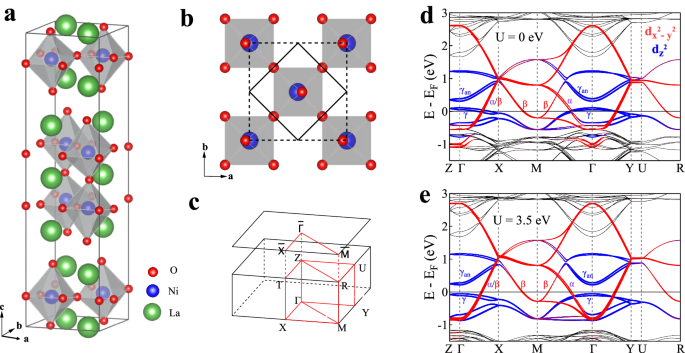
a Schematic pristine crystal structure of La3Ni2O7. b Top view of the crystal structure with a two-dimensional lattice of O and Ni atoms. Due to the out-of-plane tilted Ni-O octahedra, the apical oxygen atom is not right on the top of Ni atom. The solid black line frame represents the original unit cell without considering the tilted Ni-O octahedra and the dashed black line frame represents the real structural unit cell by considering the tilting of the Ni-O octahedra. c Three-dimensional Brillouin zone with high-symmetry points and high-symmetry momentum lines marked which are obtained based on the real structural unit cell (dashed frame in b). d and (e) Calculated band structures of La3Ni2O7 without considering U (d) and with U = 3.5 eV (e). Red color represents 3d𝑥2−𝑦2 orbital of Ni while blue color represents 3d𝑧2 orbital of Ni.
We carried out band structure calculations of La3Ni2O7 based on the DFT+U method (see Methods). Figure 1d, e shows calculated band structures of La3Ni2O7 without (U = 0, Fig. 1d) and with (U = 3.5 eV, Fig. 1e) considering the effective on-site Coulomb interaction U. The electronic states around the Fermi level come mainly from the Ni-3d𝑥2−𝑦2 and Ni-3d𝑧2 orbitals. The Ni-3d𝑧2 orbital-derived bands form two branches. The upper branch represents the anti-bonding bands (γan) while the lower branch represents the bonding bands (γ) originated from the strong inter-layer coupling between the two Ni-3d𝑧2 orbitals via the O-2pz orbitals of the intermediate apical oxygen.
Such a coupling results in a large energy splitting between the two branches which gives rise to a separation (between γ and γan in Fig. 1d) of ~0.2 eV. The Ni-3d𝑧2 orbitals form a flat band (γ band in Fig. 1d) around Γ and it slightly crosses the Fermi level. The Ni-3d𝑥2−𝑦2 orbitals form two kinds of bands (α and β in Fig. 1d, e) due to the in-plane coupling of the Ni-3d𝑥2−𝑦2 orbitals via the intermediate O-2px/y orbitals. Both the α and β bands cross the Fermi level.
When the effective on-site Coulomb interaction is turned on (U = 3.5 eV, Fig. 1e), it causes a small effect on the overall band structures of La3Ni2O7 around the Fermi level when compared with the case of U = 0 (Fig. 1d). The upper branch of the Ni-3d𝑧2 derived bands, as well as the Ni-3d𝑥2−𝑦2 derived α and β bands, exhibits a weak change with or without considering U. The most notable effect is on the lower branch of the Ni-3d𝑧2 derived bands. Upon turning on U, these bands increases in the band width and the overall energy position shifts downwards to the high binding energy. This results in an obvious change of the γ band near Γ. It crosses the Fermi level for U = 0 (Fig. 1d) but sinks ~50 meV below the Fermi level for U = 3.5 eV (Fig. 1e).
Fermi surface of La3Ni2O7
Figure 2 shows the Fermi surface mapping of La3Ni2O7 measured at 18 K by using both synchrotron (Fig. 2a) and laser (Fig. 2b) light sources. The typical band structures along high-symmetry directions are presented in Fig. 3. In Fig. 2a, b, the original first Brillouin zone is marked by the solid black line and the corresponding folded first Brillouin zone is marked by the dashed black line. Two main Fermi surface sheets are clearly observed, as quantitatively shown in Fig. 2c. Due to the lattice distortion (Fig. 1b), the original α and β Fermi surface are folded to form 𝛼′ and 𝛽′ Fermi surface, as observed in Fig. 2a and plotted in Fig. 2c. In addition, we also observed features (green dashed line in Fig. 2a) that cannot be attributed to the α and β Fermi surface or their folded Fermi surface 𝛼′ and 𝛽′. This feature is observed in synchrotron-based ARPES measurements (Fig. 2a) but not in the laser-based ARPES measurements with a small spot size of ~15 μm (Fig. 2b and Supplementary Fig. 1). The feature is not expected in the band structure calculations (Fig. 1d, e). We therefore tend to believe that it may originate from other impurity phase in the measured sample. Since the extra feature follows the same Brillouin zone as La3Ni2O7, it is possible that it comes from intergrowth phase.
Fig. 2: Measured Fermi surface of La3Ni2O7 and its comparison with the band structure calculations.
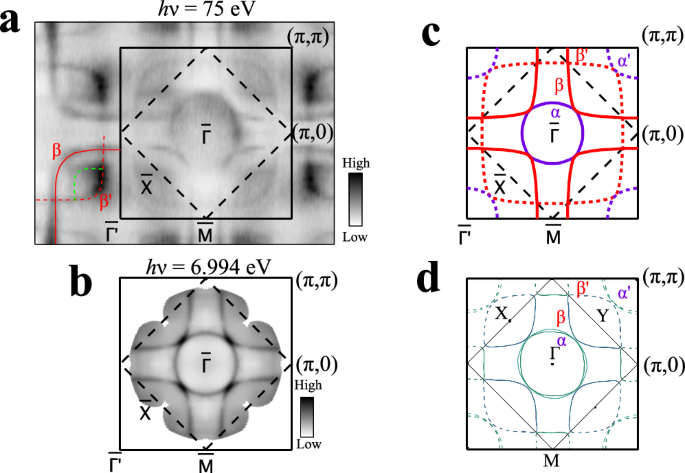
a Fermi surface mapping measured at 18 K by using synchrotron-based ARPES with a photon energy of 75 eV. It is obtained by integrating the spectral intensity within 20 meV with respect to the Fermi level. b Fermi surface mapping measured at 18 K by using laser-based ARPES with a photon energy of 6.994 eV. It is obtained by integrating the spectral intensity within 10 meV with respect to the Fermi level. The Fermi surface mappings in (a) and (b) are obtained by symmetrization assuming four-fold symmetry. Two main Fermi surface sheets (α and β) are clearly observed. The solid line frame represents the first Brillouin zone from the original unit cell (solid line frame in Fig. 1b) while the dashed line frame represents the first Brillouin zone from the real unit cell (dashed line frame in Fig. 1b). c Measured Fermi surface of La3Ni2O7 obtained from (a) and (b). It consists of two main Fermi surface sheets, α and β, and their folded Fermi surface, 𝛼′ and 𝛽′. d Calculated Fermi surface with U = 3.5 eV obtained from the first-principles calculations (Fig. 1e). The calculated Fermi surface shows an excellent agreement with the measured Fermi surface in (c).
Fig. 3: Band structures of La3Ni2O7 measured at 18 K along high-symmetry directions from synchrotron-based ARPES with a photon energy of 75 eV.
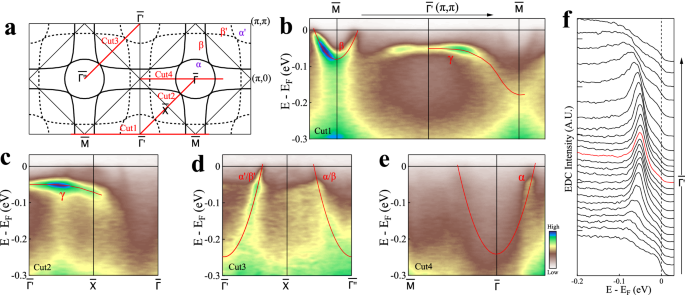
a Schematic Fermi surface of La3Ni2O7 with the momentum cuts marked. b–e Band structures measured along momentum cuts Cut1, Cut2, Cut3 and Cut4, respectively. The location of the momentum cuts is shown by red lines in (a). The observed bands are labeled by their corresponding Fermi surface and shown by guidelines. f EDC stack of the flat band γ from (b). The momentum region is marked by the arrowed line on top of (b).
The measured Fermi surface of La3Ni2O7 consists of an electron-like α sheet and a hole-like β sheet (Fig. 2c). This Fermi surface topology is similiar to that of La4Ni3O1041 regarding the Ni-3d𝑥2−𝑦2 orbital derived α and β Fermi surface. One obvious difference is that the γ band crosses the Fermi level in La4Ni3O10 forming the γ Fermi surface41 while it stays below the Fermi level in La3Ni2O7 without forming a Fermi surface.
The measured Fermi surface of La3Ni2O7 is not compatible with the band structure calculations with U = 0 (Fig. 1d). Without considering U, the γ band crosses the Fermi level and forms a γ Fermi surface around Γ. This is different from the measured Fermi surface where the γ band lies below the Fermi level (Fig. 3b) without the formation of γ Fermi surface. To reconcile the discrepancy, the effective on-site Coulomb interaction U has to be added in the band structure calculations. With U = 3.5 eV, the γ band around Γ shifts downwards to ~50 meV below the Fermi level which is consistent with the measured position of the γ band (Fig. 3b). Also the calculated Fermi surface (Fig. 2d) agrees well with the measured one (Fig. 2c). The addition of sizable U in the band structure calculations indicates that there is a strong effect of Coulomb interaction in La3Ni2O7.
From the area of the measured Fermi surface (Fig. 2c), the doping level of the α sheet is estimated to be ~0.20 electron/Ni and the doping level of the β sheet corresponds to ~1.25 hole/Ni. This results in the overall doping of ~0.95 electron/Ni. From the calculated Fermi surface in Fig. 2d, the doping levels of the α and β Fermi surfaces are 0.25 electron/Ni and 1.25 hole/Ni, respectively. This gives an overall doping level of 1.0 electron/Ni. The measured doping levels show a good agreement with the calculated ones. They indicate that in La3Ni2O7 the Ni-3d𝑥2−𝑦2 orbital derived bands are doped with 1 electron/Ni.
Measured band structures of La3Ni2O7
Figure 3 shows band structures of La3Ni2O7 measured along several high-symmetry directions. The observed bands are marked by the guidelines. We took momentum cuts in both the first and second Brillouin zones because, due to the photoemission matrix element effects, the observed bands may show different spectral intensity even though the momentum cuts are equivalent in the momentum space. The α band is observed along the Γ¯-𝑀¯ momentum cut (Cut4, Fig. 3e). The β band is observed around 𝑀¯ along the 𝑀¯-Γ¯-𝑀¯ momentum cut (Cut1, Fig. 3b). Along the Γ¯-𝑋¯-Γ′¯ momentum cut (Cut3, Fig. 3d), the α and β bands are nearly degenerates and clearly observed. The γ band are observed around Γ¯ (π,π) along the 𝑀¯-Γ¯-𝑀¯ momentum cut (Cut1, Fig. 3b) and the Γ¯-𝑋¯-Γ′¯ momentum cut (Cut2, Fig. 3c). The corresponding photoemission spectra (energy dispersive curves, EDCs) are shown in Fig. 3f. The γ band is nearly flat around Γ¯ (π,π) over a large momentum region. It lies ~50 meV below the Fermi level. We found that the energy position of the flat band slightly changes between 30 ~ 50 meV in different samples we measured. This is likely due to the sample inhomegeneity, particularly the oxygen content variation in La3Ni2O7−δ42. We note that there is a strong spectral weight buildup below the observed bands. This is particularly clear for the β band around 𝑀¯ in Fig. 3b. They can also be observed for the α/β bands in Fig. 3d. These observations are similiar to the waterfall band structures observed in cuprate superconductors which can be attributed to the strong electron correlations in the measured materials43,44,45,46,47,48.
To investigate the orbital characters of different bands in La3Ni2O7, we carried out polarization-dependent ARPES measurements as shown in Supplementary Fig. 1. Based on the analysis of the photoemission matrix element effects as described in Supplementary Note 1, the results are consistent with the orbital assignment that the α/β bands are dominated by the Ni-3d𝑥2−𝑦2 orbital while the γ band is dominated by the Ni-3d𝑧2 orbital.
Temperature dependence of the γ flat band in La3Ni2O7
In order to check on the nature of the γ flat band in La3Ni2O7, we carried out temperature-dependent measurements of the band as shown in Fig. 4. These data are measured with 85 eV photon energy. The temperature-dependent band structures along the Γ′¯-𝑀¯-Γ′¯ direction are shown in Fig. 4a and the extracted EDCs at Γ′¯(π,π) are plotted in Fig. 4c. The flat band changes little with temperature and stays at the similar position (~40 meV) below the Fermi level over the temperature range of 18 ~ 163 K. It was found that La3Ni2O7 exhibits a resistivity anomaly at ~110 K and a magnetic susceptibility anomaly at ~153 K40. Our results indicate that the flat band in La3Ni2O7 does not change in its energy position both across the resistivity anomaly temperature and across the susceptibility anomaly temperature. This is different from the case of La4Ni3O10. In La4Ni3O10, the flat band near (π,π) crosses the Fermi level above the resistivity anomaly temperature (~140 K). But it opens a gap of ~20 meV below the resistivity anomaly temperature and stays ~20 meV below the Fermi level at low temperature41. The different behaviors of the flat band near (π,π) make La3Ni2O7 distinct from La4Ni3O10.
Fig. 4: Temperature dependence of the γ flat band in La3Ni2O7.
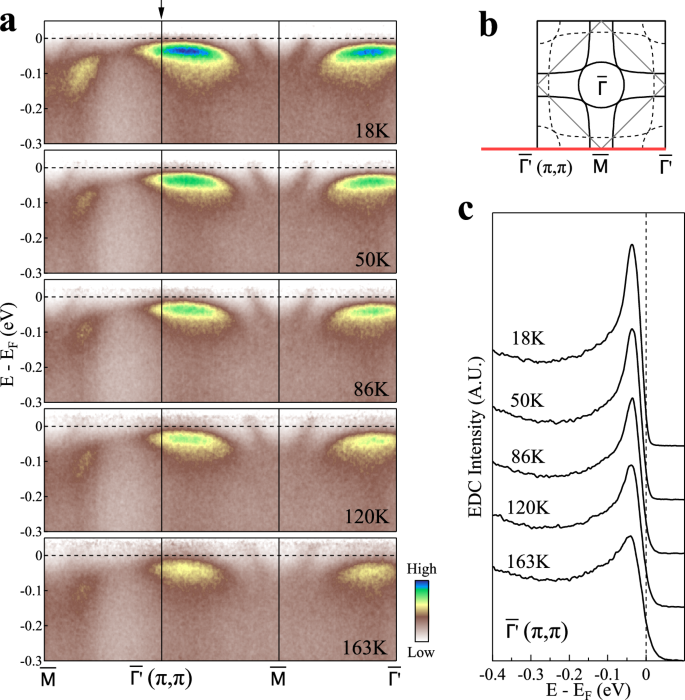
a Band structures measured along the Γ′¯-𝑀¯-Γ′¯ direction at different temperatures using 85 eV photon energy. The location of the momentum cut is shown by the red line in (b). b Schematic Fermi surface of La3Ni2O7 with the momentum cut marked. c EDCs at the Γ′¯(π,π) point at different temperature from a. The corresponding momentum postion is marked by the arrow in a.
Band remormalizations in La3Ni2O7
Figure 5 shows a quantitative comparison between the measured bands and the calculated ones with U = 0 (Fig. 5a–c) and U = 3.5 eV (Fig. 5d, e). Here we present the results of all the α, β and γ bands along two high-symmetry directions: one is along the axes while the other is along the diagonal as shown in the inset of Fig. 5d. It is clear that the calculated bands are obviously wider than the measured ones. By renormalizing the calculated bands with a factor to match the measured dispersions, we obtain the mass renormalization factors for different bands measured along different momentum directions as shown in Fig. 5f. The mass renormalization is found to be strongly orbital-dependent. The Ni-3d𝑥2−𝑦2 derived α and β bands exhibit relatively weak band renormalization (~2) and they are nearly isotropic in the momentum space. On the other hand, the Ni-3d𝑧2 derived γ band shows a strong band renormalization (5 ~ 8) which is also momentum-dependent. These indicate the Ni-3d𝑧2 derived γ band shows much stronger electron correlation than the Ni-3d𝑥2−𝑦2 derived α and β bands in La3Ni2O7. It is usually considered that, if an energy band is fully occupied, there is no correlation effects and hence no band renormalization. It is therefore interesting that in La3Ni2O7, although the Ni-3d𝑧2-derived flat band lies below the Fermi level, it exhibits strong band renormalization effect. Our density functional theory calculations reveal that, in this bilayer phase, the two nearest intra-layer Ni cations exhibit significant interlayer coupling through two Ni-3d𝑧2 orbitals via the apical oxygen. This coupling arises from the quantum confinement of the NiO2 bilayer within the structure, resulting in an energy splitting of Ni cations that makes the Ni-3d𝑧2 bonding bands lower in energy and fully occupied. However, for each Ni cation, only one electron is occupied in the Ni-3d𝑧2 orbital. Consequently, the Ni-3d𝑧2 orbital is half-filled, leading to the effects of band renormalization in La3Ni2O7.
Fig. 5: Orbital- and momentum-dependent band renormalization in La3Ni2O7.
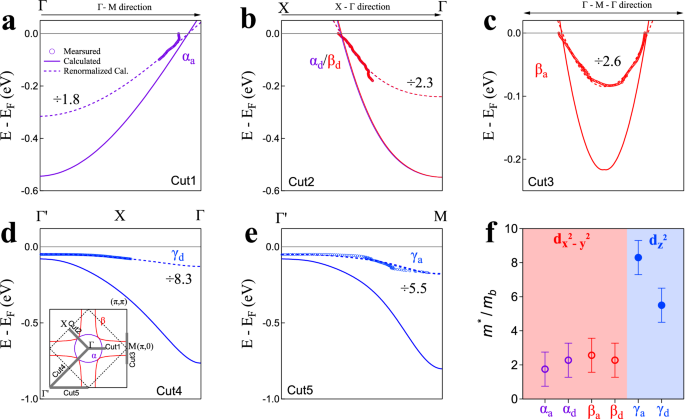
a–e Measured band dispersions (empty circles) and the corresponding calculated bands (solid lines) from Fig. 1d,e along the momentum cuts Cut1-Cut5, respectively. The location of the momentum cuts is marked by solid gray lines in the inset of (d). To match the observed dispersions, the dashed curves are the renormalized bands obtained from the calculated bands scaled by the corresponding mass enhancement values as shown in each panel. f Measured mass enhancements of the α, β and γ bands. For each band, it is further divided into two directions, along the axes (αa, βa and γa) and along the diagonal direction (αd, βd and γd). The error bars reflect the uncertainty in determining the band renormalization factors.
Discussion
The high temperture superconductivity in La3Ni2O7 is realized by applying high pressure10. It is found that there is a pressure-induced phase transition from the orthorhombic phase with a space group Amam to another orthorhombic phase with a space group Fmmm10. This is accompanied by a change of the bond angle of Ni-O-Ni from 168.0∘ at ambient pressure to 180° at high pressure along the c axis and a dramatic reduction of the inter-atomic distance between the Ni and apical oxygen from 2.297 Å at ambient pressure to 2.122 Å at high pressure10. The key question is which orbitals play the dominant role in producing superconductivity in La3Ni2O7 and whether the strong electron correlations are involved.
Our measured electronic structures of La3Ni2O7 at ambient pressure are consistent with the calculated results including sizable effective on-site Coulomb interaction. We found that there are strong electron correlations in La3Ni2O7 which are orbital- and momentum-dependent. The Ni-3d𝑧2 derived γ band shows much stronger electron correlation than the Ni-3d𝑥2−𝑦2 derived α and β bands. It supports the picture that the Ni-3d𝑧2 orbital is more localized. The ferromagnetic Hund’s rule coupling J may also contribute to the strong band renormalization because of its competition with the hybridization between Ni-3d𝑧2 orbitals and Ni-3d𝑥2−𝑦2 orbitals. Since Ni-3d𝑧2 orbitals are half-filled in La3Ni2O7, like the Cu-3d𝑥2−𝑦2 orbitals in the parent cuprate compounds, the observed strong band renormalization of the γ band may be related to the Mott physics. On the other hand, DMFT calculations30 indicate that increasing the onsite Coulomb repulsion U alone does not significantly enhance band renormalization. It does not produce an obvious orbital-selectivity either. Only when the Hund’s rule coupling J is considered can the orbital-selective strong band renormalization be realized30. Our observation of strong orbital-selective band renormalizations indicates that the Hund physics is at play in La3Ni2O7. These features show that La3Ni2O7 is a unique compound with orbital-selective Mott and Hund physics.
Since it is difficult to measure the electronic structure of La3Ni2O7 under high pressure by ARPES due to technical limitation, we carried out DFT+U calculation at 29.5 GPa and compared it with that at ambient pressure (as shown in Supplementary Fig. 2). Band structure calculations indicate that the γ bands derived from the Ni-3d𝑧2 orbital undergo a pronounced change in the energy position under pressure; it is below the Fermi level at ambient pressure but crosses the Fermi level under high pressure. On the other hand, its band width only slightly increases under high pressure primarily due to the enhanced inter-layer interaction. The band renormalization effect is expected to exhibit a small change with pressure and the electron correlation effect remains strong under high pressure. This is consistent with many theoretical proposals that the Ni-3d𝑧2 orbital-derived flat band is expected to play the dominant role in generating superconductivity in La3Ni2O710,16,18,19,22,24.
For a new unconventional superconductor like La3Ni2O7, the determination of its electronic structures is a prerequisite to establish theories to understand superconductivity. Understanding the electronic structure of La3Ni2O7 at ambient pressure is essential for understanding its electronic structure under high pressure. Since La3Ni2O7 is a strongly correlated system, it is uncertain how well its electronic structures can be represented by the band structure calculations. Our first ARPES measurements are necessary and significant to provide direct electronic structure information to check on the reliability of band structure calculations and establish theories to understand superconductivity in La3Ni2O7.
Methods
Growth of single crystals
The single crystals of double-layer nickelate La3Ni2O7 were grown by using a high-pressure floating zone method10,40. Typical sample size is ~ 1 mm. It is noted that La3Ni2O7 single crystal may become weakly insulating at ambient pressure due to the oxygen deficiency49,50. Therefore, our samples are annealed under high oxygen pressure of 100 atmospheres at 500°C before ARPES experiments. After the annealing, the magnetic measurement shows the consistent result with that in ref. 40.
ARPES measurements
Synchrotron-based ARPES measurements were performed at the beamline BL09U and BL03U of the Shanghai Synchrotron Radiation Facility (SSRF) with a hemispherical electron energy analyzer DA30L (Scienta-Omicron). The energy resolution was set at 10 ~ 15 meV. High-resolution ARPES measurements were also performed using a lab-based ARPES system equipped with the 6.994 eV vacuum-ultra-violet (VUV) laser and a hemispherical electron energy analyzer DA30L (Scienta-Omicron)51,52. The energy resolution was set at 1 meV and the angular resolution was 0.3 degree. The momentum coverage is increased by applying bias on the sample during the ARPES measurements53 (Supplementary Fig. 1). All the samples were cleaved in situ at a low temperature of 18 K and measured in ultrahigh vacuum with a base pressure better than 5 x 10−11 mbar. The Fermi level is referenced by measuring on clean polycrystalline gold that is electrically connected to the sample.
Band structure calculations
The first-principles calculations are performed based on the density functional theory as implemented in the Vienna ab initio simulation package (VASP)54,55. The generalized gradient approximation (GGA) of Perdew-Burke-Ernzerhof (PBE)56 form is used for exchange-correlation functional. The projector augmented-wave (PAW) potential57 with a 600 eV plane-wave cutoff energy is employed. A Γ-centered 19 × 19 × 5 k-points mesh with Monkhorst-Pack scheme is used for self-consistant and Fermi-surface calculations. The lattice parameters are fixed to the experimentally refined lattice constants58, and the atomic positions are fully optimized until the forces on each atom are <10−3 eV/Å, and the energy convergence criterion is set to be 10−6 eV.
To address the effect of strong Coulomb interaction, we employed DFT+U method as described in ref. 59. To determine the U parameter, we tested the U-values with 3, 3.5 and 4 eV. The position of the γ band closely matches the experimental measurement (~50 meV below the Fermi level) when U is set to 3.5 eV. Consequently, an effective Hubbard U = 3.5 eV is taken for the 3d electrons of Ni cations in this work.
Data availability
All data are processed by using Igor Pro 8.02 software. All data needed to evaluate the conclusions in the paper are available within the article. All raw data generated during the current study are available from the corresponding author upon request.
Code availability
The codes used for the DFT calculations in this study are available from the corresponding authors upon request.
Source: https://tinyurl.com/mp4c26x2 via Nature

